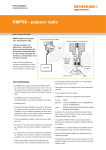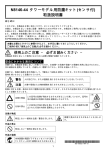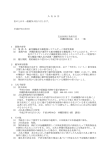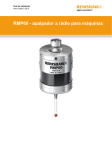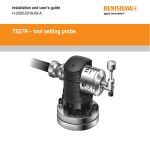Download LTO2 probe system for lathes – Installation and user's guide
Transcript
Installation and user’s guide H-2000-5032-06-A LTO2 probe system for lathes © 2001 – 2005 Renishaw plc. All rights reserved. This document may not be copied or reproduced in whole or in part, or transferred to any other media or language, by any means, without the prior written permission of Renishaw. The publication of material within this document does not imply freedom from the patent rights of Renishaw plc. Trademarks RENISHAW® and the probe emblem used in the RENISHAW logo are registered trademarks of Renishaw plc in the UK and other countries. apply innovation is a trademark of Renishaw plc. All other brand names and product names used in this document are trade names, service marks, trademarks, or registered trademarks of their respective owners. Disclaimer Considerable effort has been made to ensure that the contents of this document are free from inaccuracies and omissions. However, Renishaw makes no warranties with respect to the contents of this document and specifically disclaims any implied warranties. Renishaw reserves the right to make changes to this document and to the product described herein without obligation to notify any person of such changes. Renishaw part no: H-2000-5032-06-A Issued: 06.2005 Patents Features of the Renishaw equipment described in this guide, and features of similar equipment, are the subject of the following patents and/or patent applications: EP 0283486 EP 0337669 EP 0390342 EP 0695926 JP 2,653,806 JP 2,945,709 JP 2,994,401 US 4899094 US 5,040,931 US 5,150,529 US 5,669,151 WO 88/02139 Contents 1 PRELIMINARY USING THE PROBE Safety .............................................................. 3 Modes of operation ....................................... 18 Warranty ......................................................... 3 Setting the LTO2 OMP switches .................. 20 CNC machine ................................................. 3 Caring for the probe / LTO2-OMP .................. 3 Probe IP rating ................................................ 3 Related publications ....................................... 3 GENERAL Introduction ..................................................... 4 MAINTENANCE Battery life expectancy ................................. 22 Removing and replacing the battery ............ 23 Screw torque values ..................................... 24 FAULT FINDING ........................................... 25 Typical probe systems .................................... 6 PARTS LIST ................................................. 28 Using two OMMs ............................................ 7 APPENDIX A Dimensions ..................................................... 8 MA4 adaptor and extension bars ................. 30 System performance ...................................... 9 Performance: LTO2 and OMM ...................... 10 Performance: LTO2 and OMI ........................ 12 INSTALLATION AND CALIBRATION Installation – points to consider .................... 14 Probe mounting and stylus on-centre adjustment ................................................ 16 Attaching the MA4 90° adaptor and extensions ................................................. 17 2 Preliminary information FCC DECLARATION (USA) EC DECLARATION OF CONFORMITY Renishaw plc declares that the products: Name LTO2 series Description Optical signal transmission systems. have been manufactured in conformity with the following standards: BS EN 61326: 1998/ A1:1998/A2:2001 Electrical equipment for measurement, control and laboratory use - EMC requirements. Immunity to annex A - industrial locations. Emissions to class A (non-domestic) limits. BS EN 60825-1:1993/ Safety of laser products. A1:1997/A2:2001 Part 1: Equipment classification, requirements and user’s guide. and that they comply with the requirements of the following directives (as amended): 89/336/EEC 73/23/EEC Electromagnetic compatibility Low voltage The above information is summarised from the EC Declarations of Conformity, available from Renishaw on request. FCC Section 15.19 This device complies with Part 15 of the FCC rules. Operation is subject to the following two conditions: 1. This device may not cause harmful interference. 2. This device must accept any interference received, including interference that may cause undesired operation. FCC Section 15.105 This equipment has been tested and found to comply with the limits for a Class A digital device, pursuant to Part 15 of the FCC rules. These limits are designed to provide reasonable protection against harmful interference when the equipment is operated in a commercial environment. This equipment generates, uses, and can radiate radio frequency energy and, if not installed and used in accordance with the instruction manual, may cause harmful interference to radio communications. Operation of this equipment in a residential area is likely to cause harmful interference, in which case you will be required to correct the interference at your own expense. FCC Section 15.21 The user is cautioned that any changes or modifications not expressly approved by Renishaw plc, or authorised representative could void the user's authority to operate the equipment. FCC Section 15.27 The user is also cautioned that any peripheral device installed with this equipment such as a computer, must be connected with a high-quality shielded cable to insure compliance with FCC limits. Preliminary information ! Safety Only qualified persons should change the switch settings or replace fuses. Where appropriate, remove the mains supply from units before removing covers. Warranty Equipment requiring attention under warranty must be returned to your supplier. No claims will be considered where Renishaw equipment has been misused, or repairs or adjustments have been attempted by unauthorised persons. CNC machine CNC machine tools must always be operated by competent persons in accordance with manufacturers instructions. Caring for the probe / LTO2 OMP Keep system components clean and treat the probe system as a precision tool. 3 Probe IP rating IPX8 Related publications As you install the LTO2 probe system, you will also need to refer to one or more of the publications listed below for details of how to install the ancillary equipment. ● Optical module machine (OMM) installation and user’s guide – Renishaw part No. H-2000-5044. ● MI 12 interface unit installation and user’s guide – Renishaw part No. H-2000-5073. ● Optical machine interface (OMI) installation and user’s guide – Renishaw part No. H-2000-5062. ● PSU3 power supply unit installation and user’s guide – Renishaw part No. H-2000-5057. 4 Introduction LTO2 probe system components The LTO2 probe system comprises the following main components: ● An LTO2 optical module probe (OMP). ● A 3D touch-trigger inspection probe (±X, ±Y and +Z directions). This is either a Renishaw LP2 or LP2H probe. The LP2 is more sensitive that the LP2H, which has a greater resistance to vibration and can support heavier styli. The probe is mounted in the OMP. ● An optical transmitter and receiver unit (OMM) and an MI 12 machine interface unit. The interface unit may be either a freestanding MI 12 interface unit or an MI 12 interface board. ● Alternatively, an optical receiver and machine interface unit (OMI) may be used instead of the OMM and MI 12 interface. This unit combines the functions of both the OMM and MI 12 in one unit. ● A PSU3 power supply unit. This is an optional unit. It provides a 24 V supply to the interface unit when a suitable power supply is not available from the CNC machine controller. ● Renishaw software for probe routines. ● LPE extension bars. One of these can be fitted between the OMP and the LP2 probe to provide greater access to workpiece features. ● MA4 90° adaptor. This allows the LP2 probe to be mounted at 90° to the machine turret and set through 360°. Introduction (cont’d) 5 Operation Using two OMMs The LTO2 OMP is mounted in a tool position on the lathe turret and receives and transmits optical signals. Power for operation is provided by an internal battery. A 3D touch-trigger inspection probe, either an LP2 or LP2H, is mounted on the OMP. If it is not possible for one OMM to cover the full range of movement of the LTO2 OMP, a second OMM may be added. The reception cones of the OMMs are arranged to overlap so that they act as one receiver over the area they cover. A workpiece setup and inspection cycle may be included at any stage of the machining process. When a cycle is initiated, signals pass from the CNC control to the OMP, via MI 12 and OMM units. Signals also return along the same route. Remote indication The MI 12 interface unit converts the probe signals into the correct format for the CNC machine control. Instead of the OMM and MI 12 combination, an OMI may have been installed. This process signals in the same way as the OMM and MI 12. When the inspection probe contacts a surface, a PROBE STATUS LED on the MI 12 changes state and a bleep is emitted. If the MI 12 is hidden from the operator, an optional remote lamp or bleeper may be placed in a position where it is easily seen or heard. 6 Typical probe systems OMM – optical transmitter and receiver OMI – optical receiver and machine interface OMP – optical module probe Mounting bracket OMI (one) + CNC control OR OMM (one or two) + MI 12 + CNC control LTO2-OMP Workpiece Stylus OMM OMI LP2 or LP2H inspection probe Optional - PSU3 power supply unit Lathe turret Typical tool setting probe MI 12 interface unit or MI 12 board MI 5, MI 8 or MI 8-4 interface unit CNC machine control Optional - PSU3 power supply unit Socket for LP2 Using two OMMs 7 OMM 2 OMM 1 MI 12 machine interface unit or MI 12 machine interface board LTO2 OMP CNC machine control Remote indicator (optional) PSU3 power supply unit (optional) Stylus Lathe turret Workpiece LP2 or LP2H inspection probe 8 Dimensions Dimensions in mm (in) 30° 30° Stylus Ø25 (0.98) LP2 probe Ø62 (2.44) Ø25 (0.98) or Ø1.0 inch. Tolerance g6 40.8 (1.6) LTO2 OMP 50.5 (1.99) 61.9 (2.44) System performance Environment PROBE – LTO2 OMM, MI 12 INTERFACE OMI, PSU3 ! TEMPERATURE 9 CAUTION ● Switch power off when working inside electrical components. ● The probe is a precision tool. Always handle it with care. Storage –10° C to 70° C (14° F to 158° F) Operating 5° C to 50° C (41° F to 122° F) Operating envelope See pages 11 and 13. Natural reflective surfaces within the machine may increase the signal transmission range. Performance plots in the ambient temperature range 5° to 50° C (41° to 122° F) are shown on pages 11 and 13. Operation in temperatures of 0° to 5° C or 50° to 60° C (32° to 41° F or 122° to 140° F) will result in some reduction in range. ● Before using the probe, ensure it is firmly secured in its mounting. Regular maintenance Although Renishaw probes require little maintenance, the performance is adversely affected if dirt, chips or liquids are allowed to enter the sealed working parts. Therefore keep all components clean and free from grease and oil. Periodically check cables for signs of damage, corrosion or loose connections. Cleaning Coolant residue accumulating on the probe transmitter LEDs and receiving diode, and on the OMM or OMI windows has a detrimental effect on transmission performance. Wipe clean as often as is necessary to maintain unrestricted transmission. 10 Performance: LTO2 and OMM LTO2 and OMM The diodes of the LTO2 OMP and OMM must be mutually in the others field of view and within the performance envelope shown on the page opposite. Switch On/Off range The LTO2 OMP must be within 4 m (13.12 ft) of the OMM. Operating range The LTO2 OMP must be within 4 m (13.12 ft) of the OMM. Rotation of the LTO2 OMP window is to be within ±20 degrees of the optical centreline. Performance: LTO2 and OMM 1 (3.3) OMM 2 (6.5) 11 3 (9.8) 4 (13.12) 60° 45° 30° Optical centre line 15° 60° 15° 45° 30° 45° 0° 15° 30° 60° 15° Range metres (feet) SWITCH ON/OFF 4 (13.12) 30° OPERATING 3 (9.8) 45° 2 (6.5) 60° 1 (3.3) LTO2- OMP 12 Performance: LTO2 and OMI LTO2 and OMI The diodes of the LTO2 OMP and OMI must be mutually in the others field of view and within the performance envelope shown on the page opposite. Switch On/Off range The LTO2 OMP must be within 4 m (13.12 ft) of the OMI. Operating range The LTO2 OMP must be within 4 m (13.12 ft) of the OMI. Rotation of the LTO2 OMP window is to be within ±30 degrees of the optical centreline. Performance: LTO2 and OMI 1 (3.3) OMI 2 (6.5) 3 (9.8) 13 4 (13.12) 60° 45° 30° Optical centre line 15° 60° 15° 45° 15° 30° 30° 45° 0° 60° 15° Range metres (feet) SWITCH ON/OFF 30° 4 (13.12) OPERATING 3 (9.8) 45° 2 (6.5) 60° 1 (3.3) LTO2- OMP 14 Installation – points to consider Installation is the responsibility of your Renishaw supplier or the machine tool manufacturer. Information is given in this section to assist in overcoming basic problems. You are recommended to seek specialist advice where this is appropriate. Cable routing and electrical interference Care should be taken to ensure that signal cables are routed away from high current sources, e.g. high current cables, axis drive motors and 3-phase transformers. Optical interference Renishaw optical transmission systems are designed to be immune from normal optical interference. However there is a level above which powerful light sources will interfere with the optical system. There are two categories of interference: ● Intermittent light sources ● Local strong continuous light sources Intermittent light sources Rotating-type beacons with incandescent light source This type of beacon will not cause interference unless: ● it is situated within two metres of the OMM, and ● its mirror reflects light directly at the OMM. Xenon-type beacons This type of beacon produces fast, very powerful pulses of light and cannot safely be used near the OMM. It is undesirable to operate the system in an environment that contains Xenon beacons, i.e. on machine tools or AGVs. Arc, MIG or TIG welding These can produce optical interference similar to that of a Xenon beacon. Xenon beacon restrictions therefore apply. Installation – points to consider (cont’d) 15 Other interfering light sources It is possible that fast changes in light levels, e.g. a match being struck or a lighter being lit, will cause errors if the source is within 500 mm of the OMM window. Abnormal changes in light levels must therefore be avoided. Local strong continuous light sources ● If fluorescent lamps are used for workpiece lighting, the OMM should be kept at a distance of at least one metre from the source. ● If quartz halogen lamps of greater than 60 W are used, the OMM should be kept at a distance of at least two metres from direct emission from source. ● It should also be noted that direct sunlight should not be allowed to shine on the OMM window, as this could cause errors. If it is not convenient to maintain these distances and any of the problems listed above are experienced, then a shield (similar to a camera lens hood) can be used to shield the OMM from direct contact with the interference. CAUTION: If two systems are operating in close proximity to each other, take care to ensure that signals transmitted from the OMP on one machine are not received by the OMM or OMI on the other machine, and vice versa. ! OMM and OMI positioning To assist finding the optimum position of the OMM during system installation, signal strength outputs are available on the MI 12 interface. OMI signal strength is displayed on an OMI multi-coloured LED. 16 Probe mounting and stylus on-centre adjustment Probe mounting C The LTO2 OMP mounts directly in the lathe turret. 1 Align the OMP with the OMM/OMI then clamp the OMP in the turret. The probe can now be moved relative to the OMP. Adjuster ring A On-centre adjustment B On-centre adjustment of the stylus is carried out using the on-centre adjuster ring. Use it to adjust the stylus tip so that it corresponds with the nominal tool tip position. 1 Slacken screws A between a quarter-turn and a half-turn. The spring washers will maintain a light grip. 2 Place the adjuster ring onto the OMP, and position it with one set of opposing screws B in line with the Y-axis of the machine. 3 Tighten screws C. 4 Adjust screws B to move the probe. Progressively slacken one screw and tighten the opposite screw as the final setting is approached. Use two hexagon keys to do this. X-axis 5 When the stylus is correctly positioned, tighten screws A to 2.6 Nm (1.91 lbf.ft). 6 Slacken screws B and C and remove the adjuster ring. Attaching the MA4 90° adaptor and extensions MA4 90° adaptor This adaptor enables the probe to be mounted at 90° to the machine spindle centre line. This extra versatility allows the probe to reach otherwise inaccessible workpiece features. 1 Screw the MA4 into the OMP and tighten it with the C spanner to 10–12 Nm (7.37– 8.84 lbf.ft). The C spanner is also used to tighten the LP2 or LP2H probe in its mounting. 17 C spanner 10 – 12 Nm (7.37 – 8.84 lbf.ft) MA4 adaptor A LTO2 360° rotation LP2 2 Slacken the three screws A. 3 Rotate the MA4 to any position through 360°. 4 Tighten the three screws A to 1.1 Nm (0.81 lbf.ft). 5 Screw the LP2 or LP2H probe into the MA4 adaptor and tighten it with the C spanner to 10–12 Nm (7.37–8.84 lbf.ft). 2.5 mm AF 1.1 Nm (0.81 lbf.ft) LPE extension bars (not shown) Extension bars up to 150 mm long can be fitted between the MA4 and the probe using the C spanner provided. 18 Modes of operation Modes of operation switched-off and before it can be switched on again. The LTO2 has two modes of operation: 1 Standby mode – the OMP uses only a small current while passively waiting for the switch-on signal. This helps conserve battery life. 2 Operating mode – this is activated by one of the methods described in “Switch-on options”. Signals are transmitted by the probe only during the operating mode. LTO2 power on/off LTO2 power switch on/off occurs only when the LTO2 is located within the switch on/off envelope of the OMP and OMM/OMI. Debounce time After the probe is switched on a time delay must occur before it can be switched off. This is known as the debounce time. The delay is factory set to 5 seconds, but it can be reset to 9 seconds by resetting the internal switch. A similar delay occurs after the probe is Switch-on options Three options are provided for switching on the LTO2. These are selected by switches on the MI 12 or OMI (for details, see the MI 12 or OMI guides). 1 Manual start (Optical-on). This is initiated by the MI 12 start button (on the OMM version only). 2 Machine start (Optical-on). This is initiated by a software M-code command (factory set mode). 3 Auto start (Optical-on). This causes the system to send an optical start signal once every second and does not require a machine control input. NOTE: Auto start should not be selected when the LTO2 is set to the Optical-on/Opticaloff option. (An Auto start signal will force the LTO2 to switch on and then off at 5 or 9 second intervals.) Modes of operation (cont’d) After the probe is switched on, the debounce time must elapse before the probe can be switched off. Switch-off mode (Timeout) A timer switch automatically returns the probe to the standby mode after a selected time interval. Four timeout options are provided – 5 seconds, 9 seconds, 33 seconds and 134 seconds. The timer is factory set to 33 seconds. Other timeout periods are selected by resetting an internal switch. When the timeout period is set to either 33 seconds or 134 seconds, the timer is reset for a further 33 or 134 seconds each time the probe triggers during the operating mode. When the timeout period is set to either 5 seconds or 9 seconds, the timer is not reset each time the probe triggers during the operating mode. NOTE: A start signal received during the time the probe is on has no effect on the timeout. 19 20 Setting the LTO2 OMP switch ! IMPORTANT: Only qualified persons should change the switch settings. Switch settings NOTE: When changing the switch settings: ● Do not touch electronic components. Gaining access to the switch 1 Remove the two screws (1) and washers (2, 3) that secure the front plate (4) (see the figure on the page opposite). NOTE: Wires are attached to the back of the front plate (4). Do NOT pull off the plate but ease it off carefully. 2 Remove the front plate (4), taking care not to strain the wires. The Dual-In-Line (DIL) switch (5) is now accessible. 3 If the O-ring shows signs of damage and needs to be replaced, unsolder the wires from the front plate (4). ● Do not strain or disconnect wires. ● Do not use the tip of a pencil to change the settings. ● Keep all components clean – do not allow coolant or particles to enter the probe body. The functions and factory settings of the switches are shown on the figure on the page opposite. Refitting the front plate When the front plate of the probe is removed, the O-ring seal that protects the electronics is disturbed. 1 To ensure that the integrity of sealing is maintained when the front plate is refitted, check the condition of the O-ring and replace it if necessary. Grease the O-ring before fitting it. Setting the LTO2 OMP switch (cont’d) 21 Screw (1) 2.6 Nm (1.91 lbf.ft) Dished washer (2) Flat washer (3) Front plate (4) Switch (5) Switch settings ON 1 2 If the wires were unsoldered to allow the O-ring to be replaced, resolder them to the back of the front plate (4). 3 Refit the front plate (4). 4 Refit the two flat washers (3), dished washers (2) and screws (1). Tighten the screws to 2.4 – 2.6 Nm (1.76 – 1.91 lbf.ft). Timeout SW1 Seconds 2 3 SW2 SW3 Debounce time Seconds 5 ON ON OFF 5 9 OFF ON OFF 9 33 ❃ ON OFF ON 5 ❃ 134 ON OFF OFF 5 ❃ Factory set 22 Battery life expectancy Low battery indication The machine control may also be programmed to flag up a low battery alarm. When either the MI 12 or OMI low battery LED lights up, battery voltage is low and the end of useable battery life is approaching. The low battery LED only lights during the probe operating mode. The OMI or MI 12 interface low battery LED lights when the battery needs to be replaced. Replace the battery as soon as is practicable following a gauging cycle. Typical battery life Standby life 65 days 5% usage (72 minutes per day) Continuous use Optical on Timer off Optical on Timer off 35 days 88 hours Removing and replacing the battery 23 Battery booster module 3 V lithium battery End cover DO NOT allow coolant or debris to enter the battery compartment. DO NOT leave an exhausted battery in the probe. Dispose of an exhausted battery in accordance with local regulations. Tighten 3 mm hexagon key Removing the battery Replacing the battery 1 If the end cover is not accessible, remove the LTO2 OMP from the machine turret. 1 Insert the battery into the battery compartment, positive (+) end first. 2 Unscrew the end cover with a 3 mm hexagon key. 2 Refit the end cover and tighten to 1.0 Nm (0.74 lbf.ft). 3 Remove the battery. 3 Refit the LTO2 OMP in the turret (if removed). 4 If the LTO2 OMP has been removed from the turret, recalibrate the probe system before use. 24 Screw torque values: Nm (lbf.ft) 3 mm AF 2 Nm (1.47 lbf.ft) M16 thread Normal 10 - 12 Nm (7.37 – 8.84 lbf. ft) Maximum 20 Nm (14.74 lbf.ft) OMM or OMI 3 mm AF 2.6 Nm (1.91 lbf.ft) 8 mm AF 5 Nm (3.68 lbf.ft) 3 mm AF 1 Nm (0.73 lbf.ft) M16 HOLD 25 mm AF 25 Nm (18.44 lbf.ft) LTO2-OMP C spanner EXTENSION PROBE 2 Nm (1.47 lbf.ft) STYLUS M16 Weak link 1.20 – 1.3 Nm (0.87 - 0.94 lbf.ft) 2.5mm AF 1.1 Nm (0.81 lbf.ft) Weak link 1.20 - 1.3 Nm (0.87 - 0.94 lbf.ft) Fault finding – If in doubt, consult your probe supplier 25 PROBE FAILS TO SWITCH ON Power supply lost. Check the power supply. Probe is already switched on. Probe unable to find the target surface. Part is missing or out of position. If necessary, switch off the probe. Dead battery. Change battery. Battery installed incorrectly. Check battery installation. Probe is not properly Check alignment and aligned with OMM/OMI. that the OMM/OMI fixing is secure. Beam obstructed. Check that OMM/OMI window is clean. Remove the obstruction. OMM/OMI signal is too weak. See performance envelope on pages 11 and 13. No OMI start signal. See the OMI installation and user’s guide. No power to MI 12 or OMI Check that a stable 24 V supply is available. Check connections and fuses. PROBE STOPS IN MID-CYCLE Beam is obstructed. Check OMI/MI 12 error LED. Remove the obstruction. Probe collision. Find the cause and rectify. Damaged cable. Check the cables. PROBE CRASHES Inspection probe using When two systems are tool setting probe active, isolate the tool signals. setting probe. Workpiece obstructing Review probe software. probe path. Probe length offset missing. Review probe software. POOR PROBE REPEATABILITY Debris on the part. Clean the part. Turret repeatability poor. Verify probe repeatability using a single point move. Loose mounting of probe/loose stylus. Check and tighten as appropriate. Calibration and update Review probe software. of offsets not occurring. Calibration and probing Review probe software. speeds not the same. Calibrated feature has moved. Check the position. Measurement occurs as the stylus leaves the surface. Review probe software. 26 Fault finding – If in doubt, consult your probe supplier POOR PROBE REPEATABILITY PROBE STATUS LED FAILS TO ILLUMINATE Probing occurs within Review probe software. machine’s acceleration and deceleration zones. Battery is incorrectly fitted. Probe feedrate too high. MI 12 POWER LED FAILS TO ILLUMINATE WITH POWER ON Perform simple repeatability trials at various speeds. Temperature variation causes excessive machine and workpiece movement. Minimise temperature changes. Increase frequency of calibration. Machine has poor repeatability due to loose encoders, tight slideways and/or accident damage. Perform health check on the machine. Check the battery installation. Faulty electrical contact. Check all connections. Fuse blown. Locate and replace blown fuse. Incorrect power supply. Ensure power supply is 24 V dc. MI 12 ERROR LED REMAINS ILLUMINATED PROBE FAILS TO SWITCH OFF Probe is in Timeout mode. Wait a minimum of 2 min 20 seconds for the probe to switch off. Turret indexed, while the probe is switched on. Restore the turret to the probing position. Probe is inadvertently switched on by OMM/OMI. Increase the distance between the probe and OMM/OMI. Reduce the OMM/OMI signal strength. Beams is not aligned. Check optical alignment. Beams is obstructed. Clear obstruction. Probe is not switched on. Check that it is switched on. MI 12 LOW BATTERY LED REMAINS ILLUMINATED Battery is incorrectly fitted. Check the battery installation. Battery dead. Replace the battery. PROBE STATUS LED REMAINS ILLUMINATED Battery voltage below useable level. Replace the battery. Fault finding – If in doubt, consult your probe supplier PROBE IS TRANSMITTING SPURIOUS READINGS Damaged cables. Check and replace the cable if damage is found. Electrical or optical interference. Move transmission cables away from other cables carrying high currents. System malfunctioning or Shield from intense light sources, e.g. inducing intermittent errors. xenon beams. Electrically isolate the OMM from the machine to prevent any possibility of earth loop. Ensure there are no arc welders, stroboscopes or other high intensity light sources in close proximity to the probe system. Poorly regulated power supply. Ensure the power supply is correctly regulated. Excessive machine vibration. Eliminate vibration. Loose mountings or styli. Check and tighten loose connections. Low LP2 spring pressure. Increase the spring pressure. PROBE FAILS TO RESEAT CORRECTLY Probe trigger occurred on reseat. Move the stylus clear of the workpiece. Inner probe diaphragm is damaged. Return to the supplier if the inner diaphragm is damaged. 27 28 Parts list – Please quote the Part no. when ordering equipment Type Part No. Description System kit A-2030-0100 Comprising: LP2 probe, PS3-1C stylus, LTO2-OMP, OMM with mounting bracket and MI 12 interface unit. System kit A-2030-0101 Comprising: LP2H probe, PS3-1C stylus, LTO2-OMP, OMM with mounting bracket and MI 12 interface unit. System kit A-2115-0028 Comprising: LP2 probe, PS3-1C stylus, LTO2-OMP, OMI with mounting bracket. System kit A-2115-0029 Comprising: LP2H probe, PS3-1C stylus, LTO2-OMP, OMI with mounting bracket. LTO2-OMP A-2030-0121 LTO2-OMP (25 mm shank) complete with battery , 3 mm hexagon key, stylus on-centre adjuster and user's guide. Battery P-BT03-0006 3 V lithium battery - Duracell type DL123A Battery cap A-2030-0370 Battery cap assembly. LP2 A-2063-6098 LP2 probe complete with two C spanners and TK1 tool kit. LP2H A-2064-0002 LP2H probe complete with two C spanners and TK1 tool kit. Service kit A-2063-7542 LP2 service kit comprises: front cover, eyelid seal, spring and O-ring. MA4 adaptor A-2063-7600 MA4 90° adaptor. Extension bar A-2063-7001 LPE1- extension bar Ø25 x 50 mm long. Extension bar A-2063-7002 LPE2- extension bar Ø25 x 100 mm long. Extension bar A-2063-7003 LPE3- extension bar Ø25 x 150 mm long. Stylus Ceramic PS3-1C stylus 50 mm long with Ø6 mm ruby ball. A-5000-3709 Parts list – Please quote the Part no. when ordering equipment Type Part no. 29 Description Protection M-5000-7582 Stylus adaptor with weak link collision protection for straight steel styli. Protection M-5000-7587 Screw with weak link collision protection for disk steel styli. Protection M-5000-7588 Screw with weak link collision protection for swivel adaptor. TK1 A-2053-7531 Probe head tool kit comprising: stylus tool, hexagon keys 1.5 mm, 2.0 mm, 2.5 mm and 4.0 mm. C spanner A-2063-7587 C spanner. OMM, OMI, MI 12 and PSU3 OMM A-2033-0576 Optical module machine (OMM) complete with cable Mounting brkt A-2033-0830 Mounting bracket for OMM / OMI / OMMR OMI A-2115-0001 Optical module interface (OMI) complete with cable MI 12 A-2075-0142 MI 12 machine interface unit MI 12B A-2075-0141 MI 12 machine interface board Panel mtg A-2033-0690 Panel mounting kit for MI 12 machine interface unit PSU3 A-2019-0018 PSU3 power supply unit, 85 V – 264 V input 30 Appendix A MA4 adaptor and extension bars The MA4 90° adaptor and extension bars are described in Renishaw data sheet AEH H-2000-2120. Dimensions mm (in) MA4 90° adaptor The adaptor enables the LP2 probe to be mounted at 90° to the machine turret, and set through 360°. 33.2 (1.30) Ø40 (1.57) 360° The MA4 uses the same M16 thread as the LP2. 24 (0.94) 15 (0.59) 40.8 (1.6) LPE extension bars Further reach may be obtained by fitting an LPE extension bar between the LP2 probe and LTO2T OMP. Extension bars use the same M16 thread as the LP2 probe. Only one extension bar is permitted per installation. Stylus LP2 probe 40.8 (1.6) 38 (1.49) Ø25 (0.98) or 1 inch. Tolerance g6 LPE extension bar Ø25 (0.98) LPE1 50 (1.96) LPE2 100 (3.94) LPE3 150 (5.90) 50.5 (1.99) 61.9 (2.44) Renishaw plc New Mills, Wotton-under-Edge, Gloucestershire, GL12 8JR United Kingdom T +44 (0)1453 524524 F +44 (0)1453 524901 E [email protected] www.renishaw.com For worldwide contact details, please visit our main web site at www.renishaw.com/contact *H-2000-5032-06*








































